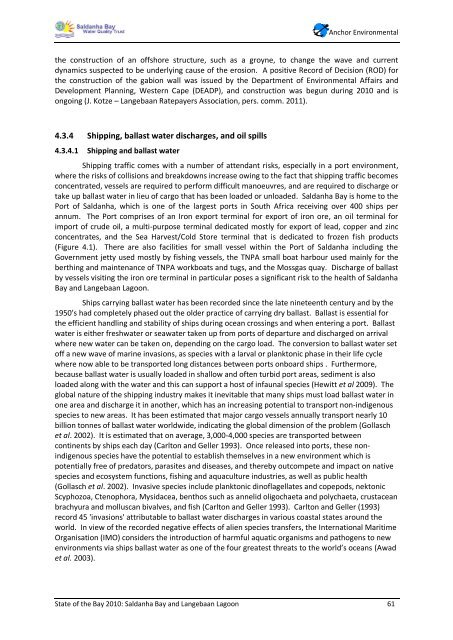State of the Bay Report 2010-Final - Anchor Environmental
State of the Bay Report 2010-Final - Anchor Environmental
State of the Bay Report 2010-Final - Anchor Environmental
Create successful ePaper yourself
Turn your PDF publications into a flip-book with our unique Google optimized e-Paper software.
<strong>Anchor</strong> <strong>Environmental</strong><br />
<strong>the</strong> construction <strong>of</strong> an <strong>of</strong>fshore structure, such as a groyne, to change <strong>the</strong> wave and current<br />
dynamics suspected to be underlying cause <strong>of</strong> <strong>the</strong> erosion. A positive Record <strong>of</strong> Decision (ROD) for<br />
<strong>the</strong> construction <strong>of</strong> <strong>the</strong> gabion wall was issued by <strong>the</strong> Department <strong>of</strong> <strong>Environmental</strong> Affairs and<br />
Development Planning, Western Cape (DEADP), and construction was begun during <strong>2010</strong> and is<br />
ongoing (J. Kotze – Langebaan Ratepayers Association, pers. comm. 2011).<br />
4.3.4 Shipping, ballast water discharges, and oil spills<br />
4.3.4.1 Shipping and ballast water<br />
Shipping traffic comes with a number <strong>of</strong> attendant risks, especially in a port environment,<br />
where <strong>the</strong> risks <strong>of</strong> collisions and breakdowns increase owing to <strong>the</strong> fact that shipping traffic becomes<br />
concentrated, vessels are required to perform difficult manoeuvres, and are required to discharge or<br />
take up ballast water in lieu <strong>of</strong> cargo that has been loaded or unloaded. Saldanha <strong>Bay</strong> is home to <strong>the</strong><br />
Port <strong>of</strong> Saldanha, which is one <strong>of</strong> <strong>the</strong> largest ports in South Africa receiving over 400 ships per<br />
annum. The Port comprises <strong>of</strong> an Iron export terminal for export <strong>of</strong> iron ore, an oil terminal for<br />
import <strong>of</strong> crude oil, a multi-purpose terminal dedicated mostly for export <strong>of</strong> lead, copper and zinc<br />
concentrates, and <strong>the</strong> Sea Harvest/Cold Store terminal that is dedicated to frozen fish products<br />
(Figure 4.1). There are also facilities for small vessel within <strong>the</strong> Port <strong>of</strong> Saldanha including <strong>the</strong><br />
Government jetty used mostly by fishing vessels, <strong>the</strong> TNPA small boat harbour used mainly for <strong>the</strong><br />
berthing and maintenance <strong>of</strong> TNPA workboats and tugs, and <strong>the</strong> Mossgas quay. Discharge <strong>of</strong> ballast<br />
by vessels visiting <strong>the</strong> iron ore terminal in particular poses a significant risk to <strong>the</strong> health <strong>of</strong> Saldanha<br />
<strong>Bay</strong> and Langebaan Lagoon.<br />
Ships carrying ballast water has been recorded since <strong>the</strong> late nineteenth century and by <strong>the</strong><br />
1950’s had completely phased out <strong>the</strong> older practice <strong>of</strong> carrying dry ballast. Ballast is essential for<br />
<strong>the</strong> efficient handling and stability <strong>of</strong> ships during ocean crossings and when entering a port. Ballast<br />
water is ei<strong>the</strong>r freshwater or seawater taken up from ports <strong>of</strong> departure and discharged on arrival<br />
where new water can be taken on, depending on <strong>the</strong> cargo load. The conversion to ballast water set<br />
<strong>of</strong>f a new wave <strong>of</strong> marine invasions, as species with a larval or planktonic phase in <strong>the</strong>ir life cycle<br />
where now able to be transported long distances between ports onboard ships . Fur<strong>the</strong>rmore,<br />
because ballast water is usually loaded in shallow and <strong>of</strong>ten turbid port areas, sediment is also<br />
loaded along with <strong>the</strong> water and this can support a host <strong>of</strong> infaunal species (Hewitt et al 2009). The<br />
global nature <strong>of</strong> <strong>the</strong> shipping industry makes it inevitable that many ships must load ballast water in<br />
one area and discharge it in ano<strong>the</strong>r, which has an increasing potential to transport non-indigenous<br />
species to new areas. It has been estimated that major cargo vessels annually transport nearly 10<br />
billion tonnes <strong>of</strong> ballast water worldwide, indicating <strong>the</strong> global dimension <strong>of</strong> <strong>the</strong> problem (Gollasch<br />
et al. 2002). It is estimated that on average, 3,000-4,000 species are transported between<br />
continents by ships each day (Carlton and Geller 1993). Once released into ports, <strong>the</strong>se nonindigenous<br />
species have <strong>the</strong> potential to establish <strong>the</strong>mselves in a new environment which is<br />
potentially free <strong>of</strong> predators, parasites and diseases, and <strong>the</strong>reby outcompete and impact on native<br />
species and ecosystem functions, fishing and aquaculture industries, as well as public health<br />
(Gollasch et al. 2002). Invasive species include planktonic din<strong>of</strong>lagellates and copepods, nektonic<br />
Scyphozoa, Ctenophora, Mysidacea, benthos such as annelid oligochaeta and polychaeta, crustacean<br />
brachyura and molluscan bivalves, and fish (Carlton and Geller 1993). Carlton and Geller (1993)<br />
record 45 'invasions' attributable to ballast water discharges in various coastal states around <strong>the</strong><br />
world. In view <strong>of</strong> <strong>the</strong> recorded negative effects <strong>of</strong> alien species transfers, <strong>the</strong> International Maritime<br />
Organisation (IMO) considers <strong>the</strong> introduction <strong>of</strong> harmful aquatic organisms and pathogens to new<br />
environments via ships ballast water as one <strong>of</strong> <strong>the</strong> four greatest threats to <strong>the</strong> world’s oceans (Awad<br />
et al. 2003).<br />
<strong>State</strong> <strong>of</strong> <strong>the</strong> <strong>Bay</strong> <strong>2010</strong>: Saldanha <strong>Bay</strong> and Langebaan Lagoon 61

















